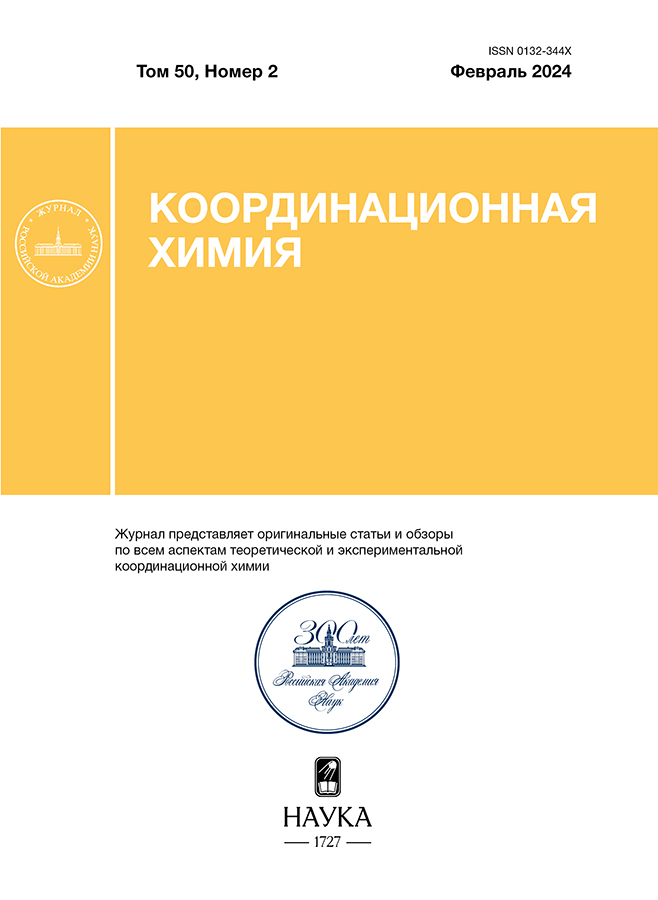Rhenium(V) Tris(pyrazolyl)borate Thiolate Complex with the Disulfide Bridging Ligand: Synthesis and Structure
- Авторлар: Skabitskii I.V.1, Shapovalov S.S.1
-
Мекемелер:
- Kurnakov Institute of General and Inorganic Chemistry, Russian Academy of Sciences
- Шығарылым: Том 50, № 2 (2024)
- Беттер: 138-144
- Бөлім: Articles
- URL: https://rjonco.com/0132-344X/article/view/667622
- DOI: https://doi.org/10.31857/S0132344X24020087
- EDN: https://elibrary.ru/ORENPO
- ID: 667622
Дәйексөз келтіру
Аннотация
The reaction of TpReOCl(StBu) (Tp = tris(pyrazolyl)borate anion) with sodium disulfide in dimethoxyethane affords the new binuclear rhenium complex [TpReO(μ-StBu)]2(μ-S2) (I). Complex I can also be synthesized by the reaction of TpReO(StBu)2 with a suspension of manganese(II) bromide in toluene accompanied by the dealkylation of one of the ligands to form one more new complex [TpReO]2(μ-S2)(μ-S) (II) containing the bridging sulfide and disulfide ligands. The structures of two crystalline solvates of complex I with dichloromethane containing the molecules with different conformations of the Re2S2 fragment (Ia and Ib) and complex II are studied by X-ray diffraction (XRD) (CIF files ССDC nos. 2262677, 2262678, and 2267423 for Ia, Ib, and II, respectively).
Негізгі сөздер
Толық мәтін
Авторлар туралы
I. Skabitskii
Kurnakov Institute of General and Inorganic Chemistry, Russian Academy of Sciences
Хат алмасуға жауапты Автор.
Email: skabitskiy@gmail.com
Ресей, Moscow
S. Shapovalov
Kurnakov Institute of General and Inorganic Chemistry, Russian Academy of Sciences
Email: skabitskiy@gmail.com
Ресей, Moscow
Әдебиет тізімі
- Trofimenko S. // Chem. Rev. 1993. V. 93. P. 943.
- Lail M., Pittard K. A., Gunnoe T. B. // Adv. Organomet. Chem. 2008. V. 56. P. 95.
- Tisato F., Bolzati C., Duatti A. et al. // Inorg. Chem. 1993. V. 32. № 10. P. 2042.
- Doonan C. J., Nielsen D. J., Smith P. D. et al. // J. Am. Chem. Soc. 2006. V. 128. Р. 305.
- McWhinnie S.L.W., Jones C. J., McCleverty J.A. et al. // Polyhedron. 1993. V. 12. P. 3743.
- Wei L.-P., Ren Z.-G., Zhu L.-W.et al.// Inorg. Chem. 2011. V. 50. P. 4493.
- Y. Arikawa, Y. Otsubo, T. Nakayama et al. // Inorg. Chim. Acta. 2019. V. 490. P. 45.
- Skabitskii I. V., Sakharov S. G., Pasynskii A. A. et al. // Russ. J. Coord. Chem. 2019. V. 45. P. 539. https://doi.org/10.1134/S1070328419080086
- SADABS (version 2008/1). Madison (WI, USA): Bruker AXS Inc., 2008.
- Sheldrick G. M. TWINABS (version 2012/1). Madison (WI, USA): Bruker AXS Inc., 2012.
- Sheldrick G. M. // Acta Crystallogr. A. 2008. V. 64. P. 112.
- Dolomanov O. V., Bourhis L. J., Gildea R. J. et al. // J. Appl. Cryst. 2009. V. 42. P. 339.
- Neese F. The ORCA Program System. Wiley Interdisciplinary Reviews – Computational Molecular Science. 2012. V. 2. P. 73.
- Perdew J. P., Burke K., Ernzerhof M. // Phys. Rev. Lett. 1996. V. 77. P. 3865.
- Perdew J. P., Burke K., Ernzerhof M. // Phys. Rev. Lett. 1997. V. 78. P. 1396 (Errata).
- Weigend F., Ahlrichs R. // Phys. Chem. Chem. Phys. 2005. V. 7. P. 3297.
- Grimme S., Ehrlich S., Goerigk L. // J. Comput. Chem. 2011. V. 32. P. 1456.
- Grimme S., Antony J., Ehrlich S. et al. // J. Chem. Phys. 2010. V. 132. P. 154104.
- Adamo C., Barone V. // J. Chem. Phys. 1999. V. 110. P. 6158.
- van Lenthe E., Baerend E. J., Snijders J. B. // J. Chem. Phys. 1993. V. 99. P. 4597.
- van Wüllen C. // J. Chem. Phys. 1998. V. 109. P. 392.
- Rolfes J. D., Neese F., Pantazis D. A. // J. Comput. Chem. 2020. V. 41. P. 1842.
- Pantazis D. A., Chen X. Y., Landis C. R. et al. // J. Chem. Theory Comput. 2008. V. 4. P. 908.
- Diemann E., Muller A. // Z. Naturforsch. B. 1976. V. 31. P. 1287.
- Cordero B., Gómez V., Platero-Prats A.E. // Dalton Trans. 2008. V. 21. P. 2832.
- Goodman J. T., Rauchfuss T. B. // Inorg.Chem. 1998. V. 37. P. 5040.
- Gourlay C., Taylor M. K., Smith P. D. et al. // Inorg. Chim. Acta. 2010. V. 363. P. 1126.
Қосымша файлдар













